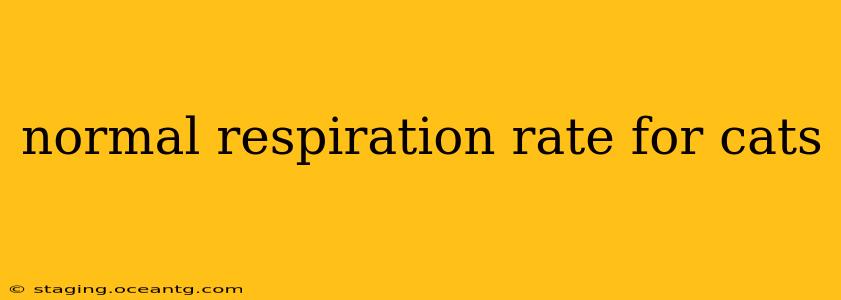Understanding your cat's breathing is crucial for recognizing potential health issues. While a cat's respiration rate can vary based on age, breed, activity level, and overall health, knowing the normal range is essential for responsible pet ownership. This guide provides a detailed look at normal feline respiration, factors affecting it, and when to seek veterinary attention.
What is the normal respiratory rate for cats?
The normal respiratory rate for a healthy adult cat at rest typically ranges from 15 to 30 breaths per minute. However, this is just an average. Kittens and very young cats may breathe slightly faster, while older cats might exhibit a slightly slower rate. It's crucial to observe your cat's breathing pattern regularly to establish a baseline for your individual pet.
How to count your cat's breaths per minute?
Accurately counting your cat's respiratory rate requires a calm and patient approach. Here's how:
- Find a comfortable spot: Choose a quiet location where your cat feels relaxed and won't be disturbed.
- Observe your cat's chest or abdomen: Gently watch the rise and fall of your cat's chest or abdomen. Each rise and fall constitutes one breath.
- Count the breaths: Count the number of breaths in one minute. It's helpful to use a stopwatch or timer to ensure accuracy.
- Repeat the process: Repeat the count several times to get a more reliable average.
What factors can affect a cat's respiratory rate?
Several factors beyond simple age can influence a cat's breathing rate:
- Activity Level: After exercise or playtime, your cat's respiratory rate will naturally increase. This is normal and will return to a resting rate once your cat is calm again.
- Temperature: High environmental temperatures can cause an elevated respiratory rate as the cat attempts to regulate its body temperature.
- Stress and Anxiety: A frightened or stressed cat might breathe faster.
- Underlying Medical Conditions: Many medical conditions, such as asthma, heart disease, and pneumonia, can cause an abnormally high or low respiratory rate. This is why establishing a baseline is so important.
- Pain: Cats experiencing pain might exhibit rapid, shallow breathing.
- Obesity: Overweight cats may have slightly elevated respiratory rates due to decreased lung capacity.
What is considered a fast breathing rate in cats (tachypnea)?
While the normal range is 15-30 breaths per minute, a respiratory rate consistently above 30 breaths per minute is generally considered tachypnea and warrants veterinary attention. This could indicate an underlying health problem.
What is considered a slow breathing rate in cats (bradypnea)?
A consistently slow respiratory rate, generally below 15 breaths per minute, can also signal a problem and should be evaluated by a veterinarian. This can be a sign of underlying issues like neurological problems or severe illness.
My cat's breathing is rapid and shallow, what should I do?
Rapid and shallow breathing is a significant sign that your cat needs immediate veterinary care. This could indicate a serious underlying issue. Do not delay seeking professional veterinary help.
When should I take my cat to the vet about its breathing?
It’s essential to contact your veterinarian immediately if you observe any of the following:
- Sustained rapid breathing (tachypnea): Breathing consistently above 30 breaths per minute.
- Sustained slow breathing (bradypnea): Breathing consistently below 15 breaths per minute.
- Difficulty breathing: Open-mouth breathing, labored breathing, or wheezing.
- Blue or grey gums: This indicates a lack of oxygen.
- Changes in breathing pattern: Unusual pauses in breathing, gasping, or other irregularities.
- Other symptoms: Lethargy, coughing, sneezing, vomiting, or loss of appetite.
Regular observation of your cat's breathing patterns and prompt veterinary attention when abnormalities are detected can help ensure your feline friend remains healthy and happy. Remember, this information is for general knowledge and does not substitute professional veterinary advice. Always consult your veterinarian for any concerns about your cat's health.
